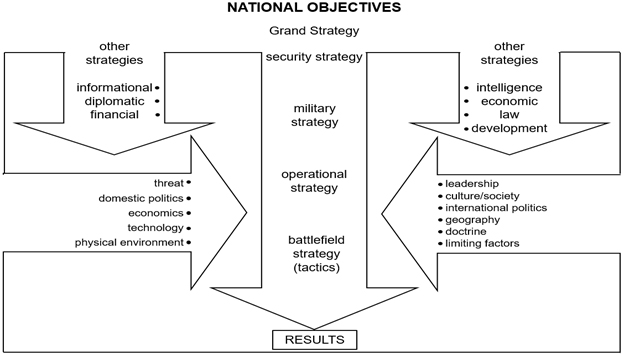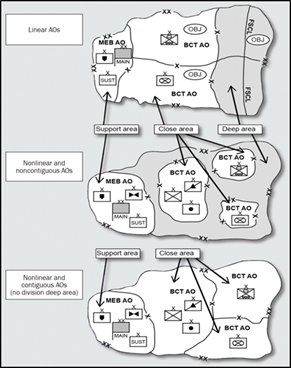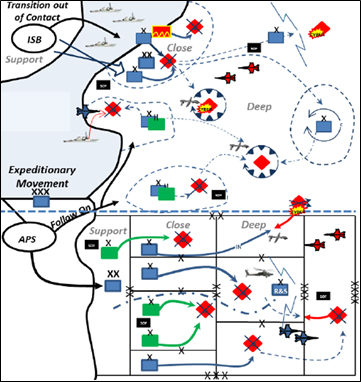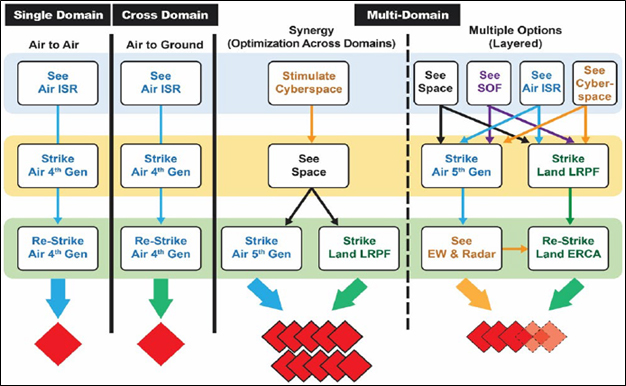Brandon C. Kasubaski
Attaining one hundred victories in one hundred battles is not the pinnacle of excellence. Subjugating of the enemy’s army without fighting is the pinnacle of excellence.
--Sun Tzu, The Art of War
The U.S is facing multifaceted challenges, including our adversaries, which it cannot favorably engage in competition and conflict. This requires creative solutions and responses from the entire Department of Defense. Last December, U.S Army Training and Doctrine Command (TRADOC) released their capstone product TRADOC Pamphlet (TP) 525-3-1, The U.S Army in Multi Domain Operations 2028. TP 525-3-1 describes how the Army contributes to deterring and defeating our adversaries in both competition and conflict. Within TP 525-3-1 the Multi-Domain Operations (MDO) concept drives the detailed solutions to problems posed by our adversaries.
However, MDO applies beyond just those threats. MDO according to TP 525-3-1 is how the Army will fight across all domains, the electromagnetic spectrum (EMS), and the information environment at echelon.1 MDO, while still at the component level, will eventually refine the Army’s role operating across multiple domains alongside the joint force.2 MDO at its core incorporates domains and capabilities previously unacknowledged and used together irregularly in war. While TP 525-3-1 establishes what MDO achieves and how it supports the Army’s strategic roles, the underlying foundational strategies and how they contribute to MDO are absent. Understanding and interpreting these foundational strategies is critical for planners and leaders to gain insight into MDO.
Defining Strategy
Despite TP 525-3-1 describing MDO as a concept in reality it’s a strategy. In the simplest of terms, strategy is bridging the gap between desired ends with available means. In the modern era, it’s more accurate to define strategy as a complex decision-making process that connects the ends sought (objectives) with the ways and means of achieving those ends.3 Strategy makes action purposeful and without it actions can be ad hoc, incoherent, and potentially counterproductive.4 Continuous assessment during the life of any strategy is required. National interests, policy, threats, capabilities, and technology often changer over time. As a result, new strategies or modifications will be required.

Figure 1: The Strategy Process
The military must continuously apply validity tests of its strategies to ensure desired national ends can be met by available military means (if required). Four forms of strategy affect the military: grand strategy, security strategy, military strategy, operational strategy, and battlefield strategy (tactics).
Grand strategy is the art and science of coordinating the development and the use of national power instruments to advance a nation’s long-term, enduring, core interest over time.5 The ways and means at this level are to achieve U.S core national interests based on the national leadership’s vision for the U.S’s international role.
Security Strategy is the art and science of coordinating the development and the use of national power instruments to achieve national security objectives.6 Security strategy is the highest-level interconnection and primary boundary between non-military instruments of power and the military. The Department of Defense looks at instruments of national power through MIDFIELD (military, informational, diplomatic, financial, intelligence, economic, law, and development).7 In security strategy, orchestrating each of these instruments of national power to be supported by and operate synergistically together allows for them to all to work more effectively.
Military strategy is the art and science of coordinating the development, deployment, and employment of military forces to achieve national security objectives.8 The terms coordination, development, deployment, and employment have specific meanings in military strategy. The development and deployment of military forces can include wartime operations but also against a communicated adversary or threat to achieve national security objectives. Employment refers unambiguously to the eventual use of forces during hostilities. Coordination at this stage refers to relationships within the military instrument of power.
Operational strategy is the art and science of planning, orchestrating, and directing military campaigns within a theater of operations to achieve national security objectives.9 At this level, Combatant Commands can develop campaign plans that outline their vision for integrating and synchronizing military activities and operations with the other national power instruments to attain national objectives.10 Campaigns achieve specific objectives through a sequence of related operations; with each operation involving a number of battles.
Battlefield strategy (tactics) is the art and science of employing forces on the battlefield to achieve national security objectives.11 What sets battlefield strategy apart from the rest of the strategies is it is concerned with doing the task correctly, while higher levels of strategy are concerned with doing the correct task.
Based on these definitions it can be determined that MDO is an operational strategy. MDO intends to develop campaign plans to win the theater war and achieve national security objectives. MDO however, also incorporates battlefield strategy for planning and executing at the tactical level of war. This is significant for leaders and planners as it means MDO allows for scalable planning from the tactical to operational level war to achieve national security objectives.
The Elements of MDO
The search for the perfect strategy has long been illusive for leaders and planners in all militaries and services. MDO strives to construct the strategy for the next war by combining elements from several previous strategies. MDO is not a new strategy but rather a recently defined strategy evolved from linear operations, non-linear operations, and strategic paralysis theory. While many may believe MDO evolved from the 1982 U.S Army Air-Land Battle doctrine, Air-Land Battle evolved from combining linear and non-linear operations. Ultimately, understanding the roots of these different strategies and how they affected MDO can aid leaders and planners to appreciate what MDO is trying to accomplish.
Linear operations. Linear operations are a relatively continuous line of contact separating well defined areas under either friendly or enemy control.12
Defined spatial and domain limits: close area, rear area, deep rear
The synchronizing of other operations with the close battle
Distinction between offense and defense planning and execution
Relatively centralized conduct of maneuver
Linear operations emphasize maintaining the position of friendly forces in relation to other friendly forces.13 Linear operations are most apt for the European model of war—a deeply arrayed, echeloned enemy force or when friendly force freedom of action is reduced because of threats to lines of communications. In these conditions, linear operations allow leaders to planners to concentrate and synchronize combat power more efficiently.
Non-linear operations. Non-linear operations (NLOs) increase the contact area between opposing forces in multiple domains, environments, or functions.

Figure 2: Linear and Non-Linear Operation Activities
No well-defined spatial or domain limits
No deep rear exists, instead “Areas of Influence” and “Areas of Interest”
Combination and simultaneity of offensive and defensive actions
Increased requirement for situational awareness, mobility, maneuverability, and flexibility
NLOs emphasize simultaneous operations along multiple lines of operations from selected bases—ashore or afloat.14 NLOs overwhelm opposing command and control (C2) and allow leaders to retain the initiative through swift maneuver against several critical vulnerabilities. Elements in NLOs rely on situational awareness coupled with precision fires rather than on mass to act on multiple objectives.
Strategic paralysis theory. Strategic paralysis theory is a military option using adversary centers of gravity (COGs) to provide focus for strategic efforts intended to disable rather than destroy the adversary (or enemy) in the shortest amount of time.15

Figure 3: MDO Scenario Depicted in Linear and Non-Linear Operations Activities
A systems analysis approach to simplify complex dynamic sociocultural phenomena by reducing them down to their basic parts or functions.16
COGs compress strategic vulnerabilities and moral fragilities into a tactical and material target set.
The creation of strategic paralysis theory traces back to Clausewitz with his discussions on COGs but recently John Boyd and John Warden better codified it. While Boyd and Warden both differed in their interpretations of strategic paralysis theory, generalities between each are present. Both men believed enemy C2 was the optimal target for military action, and that the most effective and efficient way to paralyze that C2 was determining then attacking the critical vulnerabilities or COGs of the adversary (or enemy).
Strategy Convergence
Previously, MDO changed from Multi-Domain Battle (MDB), MDB was more of a battlefield strategy and leaders believed MDO needed to be more encompassing which required elevating to the operational strategy level. Operational strategy has long been defined by component campaigns but warfare in the twenty-first century is omni-dimensional in that warfare can go through one or multiple domains (land, sea, air, space, cyber). The Army as a component has long recognized the synergy that achieved by careful orchestration of various efforts. Infantry, artillery, cavalry, Special Forces, electronic warfare, tactical ISR (intelligence, reconnaissance, and surveillance) components, close-air support (helicopter), and other various ground components have demonstrated time and again that the whole of their orchestrated efforts is greater than the sum of their individual efforts.17 However, achieving these synergistic effects often have not been easy. Modern warfare requires continuous, multi-domain coordinated, layered, and mutually supporting joint campaigns. While land, sea, air, space, and cyber have unique characteristics and at times, each seems to be independent of each other, in truth, all battles, operations, and campaigns rely on some aspect of cross-domain synergy.
The requirement for a modern strategy led to the combining of linear operations, NLOs, and strategic paralysis. However, this required elevating linear operations and NLOs above the tactical level of war and including the characteristics of all warfighting domains. Likewise, strategic paralysis theory to be more achievable needed to be shaped below the strategic level of war but above the tactical level. By MDO combining the elements of linear operations, NLOs, and strategic paralysis theory it allows leaders to better attack an adversary (or enemy) holistically. This type of warfare allows for multiple battles and operations to attack the adversary’s (or enemy’s) critical vulnerabilities or COG(s), which are the most effective, efficient, and least expensive method of returning to competition.18

Figure 4. Convergence Creating Multi-Domain Synergy and Layered Options
Typically, wars are time and resource consuming with ample opportunities for mistakes. Conversely, identifying and attacking critical vulnerabilities or COGs, allows for a reduction in time, resources, and mistakes.19 However, finding critical vulnerabilities and COGs is not the “silver bullet” to ending a war quickly. A lot of hard campaigning may be required even to get into a position to attack either one. Once in position, considerable manpower and expense may still be required.
Better Defining MDO
The current definition of MDO doesn’t accurately portray the strategies it evolves from or include already defined military terms found in Joint Publication 5-0, Joint Planning. The current MDO definition is as follows:
Operations conducted across multiple domains and contested spaces to overcome an adversary’s (or enemy’s) strengths by presenting them with several operational and/or tactical dilemmas through the combined application of calibrated force posture; employment of multi-domain formations; and convergence of capabilities across domains, environments, and functions in time and spaces to achieve operational and tactical objectives.20
A more accurate definition of MDO based on joint terminology and its foundational strategies is as follows:
A campaign, consisting of multiple battles and operations, conducted across domains, time, and contested spaces culminating in the convergence of friendly forces (Joint/Coalition) capabilities that increase limiting factors against an adversary (or enemy) and decrease limiting factors on friendly forces, opening up multiple windows of opportunity to achieve decisive blows against adversary (or enemy) critical vulnerabilities and COGs.
This proposed definition provides a clearer picture of the strategy of MDO beyond the Army’s contribution.
Critical terms. The proposed definition change of MDO included several critical terms—COGs, convergence, critical vulnerabilities, and limiting factors—these terms are important to this new definition and better describe MDO.
COGs are defined as the source of power that provides moral or physical strength, freedom of action, or will to act.21
Convergence is the rapid and continuous integration of capabilities in all domains, the electromagnetic spectrum, and information environment that optimizes effects to overmatch the enemy through cross-domain synergy and multiple forms of attack all enabled by mission command and disciplined initiative.22
Critical vulnerabilities are means or capabilities that are deficient or vulnerable to direct or indirect attack and if exploited will create decisive or significant effects.23
Limiting factors are conditions or factors, either temporarily or permanently, that impede mission accomplishment.24 Limiting factors can be equated to the Clausewitz’ terms fog of war, friction, and chance.
MDO FTW (For the Win)
Doctrine and technology often change the believed ideal relationships between various elements. For the Army, World War (WW) I and WWII brought to light the changing relationship between infantry and armor. In WWI, primitive tanks functioned as infantry support weapons. By WWII, armor had developed to the point that the relationship reversed itself. The Navy and Air Force have also recognized the synergies achieved from careful orchestration of its formations and capabilities. The documented use of Marines to seize and hold forward naval bases has long been important to fleet operations. The arrival of subsurface forces combined with surface operations transformed the nature of naval warfare. During WWII, naval aviation again transformed the nature of naval warfare by working in conjunction with surface and subsurface forces. For the Air Force during WWII, they recognized the synergy between fighter and bomber aircraft. The enemy air force would deploy upon the presence of bombers and heavy bomber losses occurred. The Air Force began conducting escort missions with fighters accompanying the bombers which allowed bombers to destroy their targets while fighters engaged enemy aircraft. Overall, the effects of these orchestrated plans allowed much greater effects than using these elements separately.
MDO’s success depends on technological developments, capabilities available, and leaders and planners’ insight in seeing how such developments and capabilities can affect the ideal relationships between operating elements. A great deal of success also depends on the nature of the enemy, their strengths, weaknesses, and vulnerabilities. MDO makes synergistic use of the unique capabilities of each warfighting domain (land, sea, air, space, and cyber) and exploiting the enemy’s weaknesses and vulnerabilities. Moreover, MDO normalizes these domains together into a synergistic whole that better achieves effects against the enemy leading to greater success. However, the orchestration of these warfighting domains is a new operating medium that provides difficult challenges to planners and leaders. Component campaigns are not a simple task and there exists further complication by the requirement of joint campaigns. MDO challenges this contention by focusing on the operational level of war and allowing for scalable planning; in that MDO allows for tactical through campaign planning. MDO requires difficult decisions that may leave many planners and leaders less than satisfied depending on their world view and priorities.
In the end, the goal of MDO is to win the theater war; that is achieve the military objective and ensure that achieving those objectives contributes in a positive sense to the accomplishment of the national security objectives. However, the only test of a successful strategy is whether it produces the outcome sought, at an acceptable cost. The key to the development of such a strategy is how objective, open-minded, insightful, and creative the leaders and planners are in answering all the fundamental questions in whichever strategy development model, framework, or methodology is employed.25 This is because the operating environment in all domains is filled with dynamic interactions and anticipations that pose fundamental problems for any doctrine or strategy theory.26 But we must continue to work on making our doctrine and strategy better. As famous British military historian, Sir Michael Howard put it—
I am tempted to declare that whatever doctrine the Armed Forces are working on, they have got it wrong. I am also tempted to declare that it does not matter that they have got it wrong. What does matter is their capacity to get it right quickly when the moment arrives. It is the task of military science in an age of peace to prevent the doctrine being too badly wrong.27
The advancement of MDO continues the trend of evolving previous strategies to fight the future war. What cannot be lost or forgotten is that strategy in practice differs from strategy in theory.
No comments:
Post a Comment